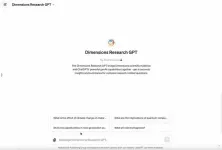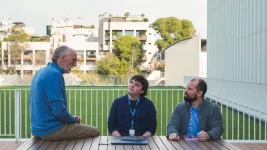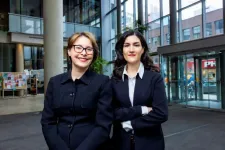(Press-News.org) LA JOLLA, CA—Molecules often have a structural asymmetry called chirality, which means they can appear in alternative, mirror-image versions, akin to the left and right versions of human hands. One of the great mysteries about the origins of life on Earth is that virtually all of the fundamental molecules of biology, such as the building blocks of proteins and DNA, appear in just one chiral form.
Scripps Research chemists, in two high-profile studies, have now proposed an elegant solution to this mystery, showing how this single-handedness or “homochirality” could have become established in biology.
The studies were published in the Proceedings of the National Academy of Sciences on February 5, 2024, and in Nature on February 28, 2024. Together, they suggest that the emergence of homochirality was due largely to a chemistry phenomenon called kinetic resolution, in which one chiral form becomes more abundant than another due to faster production and/or slower depletion.
“There have been many proposals for how homochirality emerged in specific molecules—specific amino acids, for example—but we really have needed a more general theory,” says Donna Blackmond, PhD, professor and John C. Martin Chair in the Department of Chemistry at Scripps Research, who led both studies.
Graduate student Jinhan Yu and postdoctoral research associate Min Deng, PhD, were the first authors of the two studies.
The conundrum of homochirality
“Origin of life” chemistry has been a busy field for much of the past century. Its practitioners have discovered dozens of key reactions that plausibly occurred on the early, “prebiotic” Earth to produce the first DNAs, RNAs, sugars, amino acids and other molecules that sustain life. Missing from this body of work, however, has been a plausible prebiotic theory for the emergence of homochirality.
“There has been a tendency in the field to ignore the chirality issue when looking for plausible reactions that could have made the first biological molecules,” Blackmond says. “It’s frustrating, because without reactions that favor homochirality, we wouldn't have life.”
Ordinary chemical reactions that produce chiral molecules tend to yield equal (“racemic”) mixes of left- and right-handed forms. Outside of biology, this mixing typically doesn’t matter, as both forms usually have similar or identical properties. Within biology, though, as a consequence of extensive homochirality, it is commonly the case that only the left- or the right-handed form of a chiral molecule has useful properties—the other may be inert or even toxic. Thus, cells often guide reactions to yield specific chiral forms, using highly evolved enzymes.
The prebiotic Earth would not have had such enzymes, though—so how did homochirality ever arise?
A paradoxical result
In their study in Proceedings of the National Academy of Sciences, Blackmond and her team addressed this problem for amino acids. These small organic molecules are used as building blocks for proteins by all living things on Earth, but exist in biology in just the left-handed chiral form.
The researchers specifically sought to reproduce homochirality in a central process in amino acid production called transamination, by using a relatively simple, plausibly prebiotic chemistry that excludes complex enzymes.
In early tests, the team’s experimental reaction worked, and yielded amino acids that were enriched for one chiral form versus the other. The problem was that the favored form was the right-handed form—the one that biology doesn’t use.
“We were stuck for a while, but then the light bulb went on—we realized we could do part of the reaction in reverse,” Blackmond says.
When they did that, the reaction no longer preferentially made right-handed amino acids. In a striking example of kinetic resolution, it instead preferentially consumed and depleted the right-handed versions—leaving more of the desired left-handed amino acids. It thus served as a plausible route to homochirality for amino acids used in living cells.
Tying it all together
For the Nature study, the chemists explored a simple reaction with which amino acids in the earliest life forms might have been linked together into the first short proteins (also known as peptides). The reaction had been published earlier by another researcher, but had never been investigated for its ability to produce homochiral peptides from racemic or near-racemic mixes of amino acids.
Once again, the chemists ran into what seemed to be an insurmountable obstacle: They discovered that in forming peptide chains of amino acids, the reaction worked faster for linkages of left-handed with right-handed amino acids—the opposite of the desired homochiral peptides.
Still, the team persevered. Ultimately, they discovered that when one type of amino acid in the starting pool of amino acids had even a moderate dominance of the left-handed form—as their other study made plausible—the faster reaction rate for left-handed-to-right-handed linkages preferentially depleted right-handed amino acids, leaving an ever-greater concentration of left-handed ones. Additionally, the left-right-left-right peptides had a stronger tendency to clump together and fall out of solution as solids. These kinetic resolution-related phenomena thus ended up yielding a surprisingly pure solution of almost fully left-handed peptides.
To Blackmond, the seemingly paradoxical mechanisms uncovered in these studies offer the first convincing and broad explanation for the emergence of homochirality—an explanation that probably works not only for amino acids, she says, but also for other fundamental molecules of biology such as DNA and RNA.
“Prebiotic access to enantioenriched amino acids via peptide-mediated transamination reactions” was co-authored by Jinhan Yu, Andrea Darú, Min Deng and Donna Blackmond.
“Symmetry breaking and chiral amplification in prebiotic ligation reactions” was co-authored by Min Deng, Jinhan Yu and Donna Blackmond.
Funding for both studies was provided by the Simons Foundation through the Simons Collaboration on the Origins of Life (SCOL 287625), and through the John C. Martin Endowed Chair in Chemistry at Scripps Research.
About Scripps Research
Scripps Research is an independent, nonprofit biomedical institute ranked one of the most influential in the world for its impact on innovation by Nature Index. We are advancing human health through profound discoveries that address pressing medical concerns around the globe. Our drug discovery and development division, Calibr, works hand-in-hand with scientists across disciplines to bring new medicines to patients as quickly and efficiently as possible, while teams at Scripps Research Translational Institute harness genomics, digital medicine and cutting-edge informatics to understand individual health and render more effective healthcare. Scripps Research also trains the next generation of leading scientists at our Skaggs Graduate School, consistently named among the top 10 US programs for chemistry and biological sciences. Learn more at www.scripps.edu.
END
How molecular “handedness” emerged in early biology
Scripps Research chemists fill a major gap in origin-of-life theories.
2024-02-28
ELSE PRESS RELEASES FROM THIS DATE:
The James Webb Space Telescope reveals the central role of low-mass galaxies in the reionization process of the Universe
2024-02-28
PARIS, France and BEER-SHEVA, Israel, February 28, 2024 – The James Webb Space Telescope (JWST)[1], developed by NASA and ESA, has just obtained the first spectra of very low-mass galaxies less than a billion years after the Big Bang. A technological feat made possible by the unique combination of JWST sensitivity and the gravitational lensing effect of the Abell 2744 cluster: nearby galaxies act like cosmic magnifiers, distorting space and amplifying the light of background galaxies. By demonstrating that small galaxies are very likely at the origin of the reionization of the universe, this discovery represents a major breakthrough in our knowledge of the cosmos.
The international research ...
Immunotherapy combination may benefit patients with transplanted kidneys and advanced skin cancers
2024-02-28
People who have had a kidney transplant are at high risk for developing skin cancers. New research directed by investigators from the Johns Hopkins Kimmel Cancer Center is exploring the best combination of treatments to target skin cancers while preserving the transplanted organs.
Now, they report results from a clinical trial testing a novel drug combination designed to stimulate the immune system to fight advanced, potentially lethal skin cancers while not permanently damaging patients’ transplanted kidneys. The treatment included two immune-suppressing drugs ...
Nature’s sonar: Scientists reveal how Japanese horseshoe bats perceive moving objects
2024-02-28
Unlike most animals that rely on visual senses, bats navigate and locate prey or obstacles through echolocation. By emitting sounds and comparing them to the reflected echoes, bats can “visualize” movement in the environment. When sound waves encounter a moving object, they can undergo changes such as a Doppler shift in frequency or experience a delay, which the bat can sense. However, it is unclear which acoustic characteristics bats rely on to detect moving objects.
Japanese horseshoe bats (Rhinolophus ferrumequinum nippon) emit ultrasound pulses that are characterized ...
Dimensions Research GPT – evidence-based research insights for ChatGPT platform users
2024-02-28
Digital Science is pleased to announce the launch of two new products – Dimensions Research GPT and Dimensions Research GPT Enterprise – bringing the unmatched, trusted research coverage of Dimensions to the ChatGPT platform.
Users can get AI-generated answers to research-related questions on the GPT platform informed by Dimensions’ huge database, making ChatGPT more research-specific for topic exploration.
Available to users of both the free and paid Dimensions Analytics web application, Dimensions Research GPT and Dimensions Research GPT Enterprise help overcome ...
Calcium crystal deposits in the knee contribute to joint damage
2024-02-28
(Boston)— Knee osteoarthritis (OA) is the most common form of arthritis, affecting approximately 600 million people worldwide and 34 million people in the U.S. There are no treatments available that prevent its progression to date. Recommended pharmacological treatments for symptoms have either small-to moderate effects or short-term effects, often with side effects, and lifestyle behaviors such as exercise and weight loss are under-utilized.
Historically, intra-articular mineralization (IAM) or calcium crystal deposits in the joint, were thought to be of no clinical consequence, and perhaps just something that happens with older ...
International team led by BSC develops artificial intelligence technology to improve treatment of rare diseases
2024-02-28
An international team of scientists led by ICREA researcher and Director of the Life Sciences Department at the Barcelona Supercomputing Centre - Centro Nacional de Supercomputación (BSC-CNS), Alfonso Valencia, has developed a technology based on artificial intelligence (AI) for the study of minority diseases and has successfully applied it to identify the possible causes of the appearance of what are known as myasthenic-congenital syndromes, a group of rare inherited disorders that limit the ability to move and cause varying degrees of muscle weakness in patients.
The lack of available data on minority, also known as rare, diseases makes research in this area extremely ...
Anti-cancer drug could improve symptoms after stroke
2024-02-28
A study by the Institut de Neurociències of the UAB (INc-UAB) demonstrates in animal models the benefits of vorinostat after having suffered a stroke. The drug, used in humans to treat cutaneous T-cell lymphoma, has been proved to mitigate brain injuries and help in restoring brain tissue.
Ischemic stroke is the second leading cause of death worldwide and occurs when blood flow cannot reach the brain due to an obstruction. For a more or less long period of time, the brain does not receive oxygen and this causes damage and functional impairment. Hypertension is the most frequent modifiable risk factor for stroke and is associated with worse recoveries.
Currently, ...
Consumers empowered with the facts on dairy’s nutritional benefits buy and consume more dairy foods
2024-02-28
Philadelphia, February 28, 2024 – Although most Americans consume dairy and many dairy foods are rising in popularity, fluid milk consumption has seen a significant decline among US consumers since the 1960s. To reverse this trend—and ensure consumers are getting adequate amounts of dairy in their diets—the dairy sector has developed educational materials to reach consumers through informational infographics and TV and print ads, and on social media. But do these kinds of educational ...
How air pollution can harm team performance
2024-02-28
High levels of air pollution can harm performance of teams, which are vital for solving complex problems such as developing clean energy technologies and vaccines, and this could harm economic development in highly polluted emerging economies, says a new study co-authored at Cambridge Judge Business School.
The study used data from 15,000 live escape-room games in London. It estimated based on the data and the study’s equations that for about 3,500 teams that participated for team-building exercises (usually from a corporate ...
Online toxicity can only be countered by humans and machines working together, according to Concordia researchers
2024-02-28
Wading through the staggering amount of social media content being produced every second to find the nastiest bits is no task for humans alone.
Even with the newest deep-learning tools at their disposal, the employees who identify and review problematic posts can be overwhelmed and often traumatized by what they encounter every day. Gig-working annotators, who analyze and label data to help improve machine learning, can be paid pennies per unit worked.
In a new Concordia-led paper published in IEEE Technology and Society Magazine, researchers argue that supporting ...
LAST 30 PRESS RELEASES:
Numbers in our sights affect how we perceive space
SIMJ announces global collaborative book project in commemoration of its 75th anniversary
Air pollution exposure and birth weight
Obstructive sleep apnea risk and mental health conditions among older adults
How talking slows eye movements behind the wheel
The Ceramic Society of Japan’s Oxoate Ceramics Research Association launches new international book project
Heart-brain connection: international study reveals the role of the vagus nerve in keeping the heart young
Researchers identify Rb1 as a predictive biomarker for a new therapeutic strategy in some breast cancers
Survey reveals ethical gaps slowing AI adoption in pediatric surgery
Stimulant ADHD medications work differently than thought
AI overestimates how smart people are, according to HSE economists
HSE researchers create genome-wide map of quadruplexes
Scientists boost cell "powerhouses" to burn more calories
Automatic label checking: The missing step in making reliable medical AI
Low daily alcohol intake linked to 50% heightened mouth cancer risk in India
American Meteorological Society announces Rick Spinrad as 2026 President-Elect
Biomass-based carbon capture spotlighted in newly released global climate webinar recording
Illuminating invisible nano pollutants: advanced bioimaging tracks the full journey of emerging nanoscale contaminants in living systems
How does age affect recovery from spinal cord injury?
Novel AI tool offers prognosis for patients with head and neck cancer
Fathers’ microplastic exposure tied to their children’s metabolic problems
Research validates laboratory model for studying high-grade serous ovarian cancer
SIR 2026 delivers transformative breakthroughs in minimally invasive medicine to improve patient care
Stem Cell Reports most downloaded papers of 2025 highlight the breadth and impact of stem cell research
Oxford-led study estimates NHS spends around 3% of its primary and secondary care budget on the health impacts of heat and cold in England
A researcher’s long quest leads to a smart composite breakthrough
Urban wild bees act as “microbial sensors” of city health.
New study finds where you live affects recovery after a hip fracture
Forecasting the impact of fully automated vehicle adoption on US road traffic injuries
Alcohol-related hospitalizations from 2016 to 2022
[Press-News.org] How molecular “handedness” emerged in early biologyScripps Research chemists fill a major gap in origin-of-life theories.





